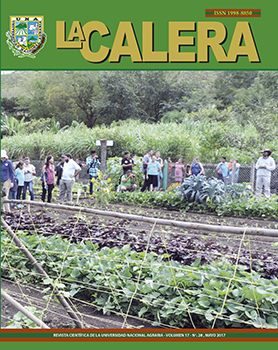Morphological characterization of local pig (Sus scrofa domesticus) in Nueva Guinea municipality, RACCS
DOI:
https://doi.org/10.5377/calera.v17i28.6365Keywords:
morphometric, phenotypic, biotypes, zoometric index, morphostructuralAbstract
The creole pig is a forgotten genetic resource, which at the moment is extremely threatened by the mestization of its genetic material with different specialized races. The present study was carried out with a total of 36 males and 57 females in the municipality of Nueva Guinea with the objective of characterizing the morphometric, phaneroptic, relationship of variables with sex and age and identifi cation of biotypes. Age and 12 morphological measures were determined, which were used to calculate 7 zoomometric indexes: cephalic (ICF), proportionality (IPD), body (ICP), chest depth (IPRP), thoracic (ITO), pelvic (IPV ), Thoracic metacarp (IMT), and phaneroptic characteristics in each individual. From the descriptive statistical analysis it was observed that the zoomometric measures evaluated reached a range of variation between 13.24% (LK) and 30.68% (DDE), reflecting that they are individuals with a high morphostructural variability. The regression analysis revealed that all body measurements are significantly related to age, but not with the variable sex that only presented positive relation with fi ve variables and in the total of the cases are not significant. With respect to zoomometric indexes, these pigs can be characterized as dolichocephalous (ICE = 42.51), longilineal (ICO = 98.75) and convexilineal (IPE), with a relatively deep trunk between the elliptic and cylindrical, reflecting values of coincident thoracic index With their condition of longils. In the phaneroptic characteristics, it is emphasized that these pigs predominate the layers and black mucous, body with abundant hair, absence of mamelles and syndactyly, with predominance of straight profiles. For the cluster analysis, four groups of animals were classified as having signifi cant differences between each of the morphometric variables evaluated. The results obtained allow us to know that they are individuals with high morphostructural variability and therefore it is diffi cult to do a zoomometric typing of the race, and on the other hand that the groups of individuals differentiated by cluster, even though they present statistically significant differences between the Different variables, cannot be considered as genetically differentiated biotypes, but rather a consequence of the environment, necessitating a treatment at a molecular level and not simply based on zootechnical measures.
Downloads
Metrics
References
Albarracín, BM. 2014. La Conservación del cerdo criollo (sus scrofa domestica), recurso alimentario de sistemas tradicionales de producción campesina. Pontificia universidad javeriana. 2014.
Benítez, OW; Sánchez, M. 2000. Los Cerdos locales en los sistemas tradicionales de producción. Estudio FAO, Producción y sanidad animal. N° 148.
Barba-Capote, CJ; Velázquez-Rodríguez, F; Perez-Freeman, F; Delgado Bermejo, JV. 1998. Contribución al estudio racial del cerdo Criollo cubano. Revista Archivos de Zootecnia, 47:51-59.
Bermejo, J.V.D; Prieto, PN; Capellari, A; Revidatti, MA. 2005. Estudio morfoestructural preliminar de una población porcina en la provincia de Corrientes. Argentina. Archivos de zootecnia, 54(206), 227-232.
Escobar, R, JC. 2007. Caracterización y Sistemas de Producción de los Cerdos Criollos del Cantón Chambo. Escuela Superior Politécnica Chimborazo. Ecuador.
Estupiñán, V; Vasco, D; Barreto, S; Zambrano, K. 2007. Estudio morfoestructural de una población de cerdos naturalizados en el cantón Valencia, provincia de Los Ríos, Ecuador. Memorias del VIII Simposio Iberoamericano sobre conservación y utilización de recursos Zoogenéticos. p 134-142.
Estupiñán, V; Vasco, D; Barreto, S; Zambrano, K. 2007. Estudio morfoestructural de una población de cerdos naturalizados en el cantón La Maná, provincia de Cotopáxi, Ecuador. Memorias del VIII Simposio Iberoamericano sobre conservación y utilización de recursos Zoogenéticos. p 166-172.
Falconí Velasco, CR; Paredes Barros, MX. 2011. Levantamiento poblacional, caracterización fenotípica y de los sistemas de producción de los cerdos criollos en los cantones de Mejía (Pichincha) y Colta (Chimborazo).
Guerrero y Soriano (1992). Historia de la Ganadería Nicaragüense. Edit. Unión. Managua. NI.
Herrera, M; Luque, M. (2009). Morfoestructura y sistemas para el futuro en la valoración morfológica. En: Valoración Morfológica de los animales domésticos. Sañudo, A, C. (Ed). Madrid, Ministerio de Medio Ambiente y Medio Rural y Marino.
Hurtado, E., González, C; Ly, J; No, GP; Brava, P. 2004. Estudio morfológico del cerdo criollo del Estado Apure, Venezuela. Revista Computarizada de Producción Porcina 11 (3).
Lorenzo, M; Jáuregui, J, Vásquez, Ch. 2012. Caracterización del Cerdo Criollo de la Región de Cho’rti’ del departamento de Chiquimula, Guatemala. Centro Universitario de Oriente, Universidad de San Carlos. Guatemala. Actas Iberoamericanas de Conservación Animal. AICA 2 (2012) 103 103-108.
Revidatti, M. (2009). Caracterización de cerdos criollos del nordeste argentino. Universidad de Córdoba.
Roche, A; Salinas, M; Santander, L; Andaluz, E, Peña, F; Herrera, M. 2006. Raza Roya Bilbilitana. Caracteres cuantitativos morfoestructurales. In XXXI Jornadas científicas. Zamora. España.
Sierra, AC; Poot, TB; Díaz, ZI; Cordero, AH; Delgado, JV. 2005. El Cerdo Pelón Mexicano, una raza en peligro.
Yépez. R. 2006. Caracterización de los porcinos criollos mestizos en la comunidad de Pungala Escuela Superior Politécnica Chimborazo. Riobamba. Ecuador












